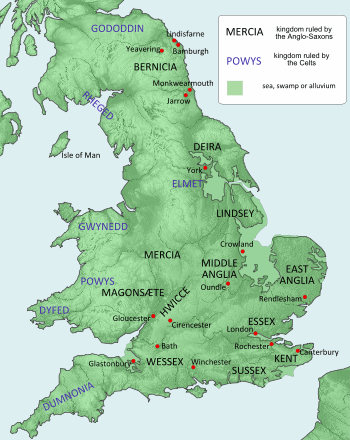Heptarchy
- This is about the historiographical convention. See History of Anglo-Saxon England for a historical discussion, and List of Anglo-Saxon kingdoms for a full list.

The Heptarchy (from the Greek ἑπτά hepta, "seven" and ἄρχω arkho, "to rule") is a collective name applied to the Anglo-Saxon kingdoms of south, east, and central England during late antiquity and the early Middle Ages, conventionally identified as seven: East Anglia, Essex, Kent, Mercia, Northumbria, Sussex, and Wessex. The Anglo-Saxon kingdoms eventually unified into the Kingdom of England.
The term has been in use since the 16th century, but the initial idea that there were seven Anglo-Saxon kingdoms is attributed to the English historian Henry of Huntingdon in the 12th century and was first used in his Historia Anglorum.[1]
Definition and historicity of the concepts

By convention the label is considered to cover the period from 500 to 850, often referred to as the Dark Ages, which approximately represents the period following the departure of Roman legions from Britain until the kingdoms came under the overlordship of Egbert of Wessex.
Though heptarchy suggests the existence of seven kingdoms, the number fluctuated, as kings contended for supremacy at various times within the conventional period.[2] In the late sixth century the king of Kent was a prominent lord in the south; in the seventh century the rulers of Northumbria and Wessex were powerful; in the eighth century Mercia achieved hegemony over the other surviving kingdoms, particulary with Offa "The Great". Yet as late as the reigns of Eadwig and Edgar (955–75), it was still possible to speak of separate kingdoms within the English population.
In reality the end of the Heptarchy was a gradual process. The 9th century Viking raids that led to the establishment of a Danish-controlled enclave at York, and ultimately to the Danelaw, gained considerable advantage from the petty rivalries between the old kingdoms. The need to unite against the common enemy was recognised, so that by the time Alfred of Wessex resisted the Danes in the late 9th century, he did so essentially as the leader of an Anglo-Saxon nation. Successive kings of Wessex (and especially Athelstan) progressively reinforced the English unitary state, until, with the simultaneous dissolution of Mercia and submission of Northumbria upon Edgar's succession in 959, the old constituent kingdoms in effect became consolidated into one.
Recent research has revealed that some of the Heptarchy kingdoms (notably Essex and Sussex) did not achieve the same status as the others. Conversely, there also existed alongside the seven kingdoms a number of other political divisions which played a more significant role than previously thought. Such were the kingdoms (or sub-kingdoms) of: Bernicia and Deira within Northumbria; Lindsey in present-day Lincolnshire; the Hwicce in the southwest Midlands; the Magonsæte or Magonset, a sub-kingdom of Mercia in what is now Herefordshire; the Wihtwara, a Jutish kingdom on the Isle of Wight, originally as important as the Cantwara of Kent; the Middle Angles, a group of tribes based around modern Leicestershire, later conquered by the Mercians; the Hæstingas (around the town of Hastings in Sussex); and the Gewisse, a Saxon tribe in what is now southern Hampshire later developing into the kingdom of Wessex.
Certainly the term Heptarchy has been considered unsatisfactory since the early 20th century, and many professional historians no longer use it, feeling that it does not accurately describe the period to which it refers. However, it is still sometimes used as a label of convenience for a phase in the development of England.
List of Anglo-Saxon kingdoms
The four main kingdoms in Anglo-Saxon England were:
- East Anglia
- Mercia
- Northumbria, including sub-kingdoms Bernicia and Deira
- Wessex
The other main kingdoms which were conquered by others entirely at some point in their history are:
Other minor kingdoms and territories include:
- Dumnonia (only subject to Wessex at a later date)
- Haestingas
- The Hwicce
- Isle of Wight
- Kingdom of the Iclingas, a precursor state to Mercia
- Lindsey
- Magonsæte
- The Meonwara, a Jutish tribe in Hampshire
- Middle Angles
- Pecsæte
- Surrey
- Tomsæte
- Wreocensæte
Attributed arms
Arms were attributed to the kingdoms of the Anglo-Saxon heptarchy in the modern period (the historical kingdoms disappeared long before the emergence of heraldry).
The Kingdom of Essex, for instance, was assigned a red shield with three notched swords (or "seaxes"). This coat was used by the counties of Essex and Middlesex until 1910, when the Middlesex County Council applied for a formal grant from the College of Arms (The Times, 1910). Middlesex was granted a red shield with three notched swords and a "Saxon Crown". The Essex County Council was granted the arms without the crown in 1932.
-

Kingdom of East Anglia
-

Kingdom of Essex
-

Kingdom of Kent
-

Kingdom of Mercia
-

Kingdom of Northumbria
-

Kingdom of Sussex
-

Kingdom of Wessex
See also
- History of Anglo-Saxon England
- Cornovii (Cornish)
- http://www.earlybritishkingdoms.com/
- Related terms: Bretwalda, High King for hegemons among Kings
- Compare: Tetrarchy
Notes
- ↑ Historia Anglorum: the history of ... - Google Books. Books.google.com.au. 1996. ISBN 9780198222248. Retrieved 2010-04-09.
- ↑ Norman F. Cantor, The Civilization of the Middle Ages1993:163f.
References
- Westermann Großer Atlas zur Weltgeschichte
Further reading
- Stenton, F. M. (1971) Anglo-Saxon England, 3rd edition. Oxford U. P.
- Campbell, J. et al. (1991) The Anglo-Saxons. Harmondsworth: Penguin
External links
- Monarchs of Britain, Encyclopædia Britannica
- The Burghal Hidage - Wessex's fortified burhs
| ||||||||||||||
| ||||||
.svg.png)